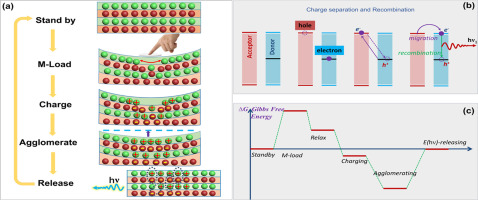Nano Energy ( IF 16.8 ) Pub Date : 2018-03-01 , DOI: 10.1016/j.nanoen.2018.02.041 Bolong Huang , Mingzi Sun , Dengfeng Peng

|
The creations of photons in response to mechanical stimulus in a crystal that has noncentral symmetry are the great fundamental physics responsible for numbers of important technologies. The underlying mechanism and complete theory for a precise explanation of the mechanical-photonic energy conversion phenomena is vital important. We take commercial piezoelectric LiNbO3 matrics as the example to interpret the detail mechanisms of energy conversions for the photon-generation through a native point defects study. It was found the Frenkel and Schottky type complex pairs as well as the antisite pair defects acting as energy harvesting and migration centers, which are very easy to form and active. It does to be the extra deep electron or hole traps levels near the valence or conduction band edge, respectively. That is the substantial energy reduction via a spontaneous equilibrium transformation from the complementarily charged individuals into agglomerated complexes. Such energy gain for both two processes turns to be independent to the variations of synthesis chemical potentials. In addition, the complex defects actually form independent to the variations of the chemical potentials. This leads to a coupling and exchange effect by them to continuously collect and transport host charges along the path via localized states to the deep recombination levels. The initiating energy barrier is small which ambient thermal stimulation or quantum tunneling can accomplish. The native sensitizers such as VNb2O5, VLiNbO3, NbLi are also the energy conversion centers to non-radiative resonant energy transfer onto the activator center at the Oi to transfer the energy into photon emissions. A generalized energy conversion mechanism has been unraveled in this work. This gives a solid theoretical reference for developing the mechanical-photonic energy conversion materials.
中文翻译:

压电材料中光子产生的内在能量转换:以碱性铌酸盐为例
响应具有非中心对称性的晶体中的机械刺激,光子的产生是负责许多重要技术的重要基础物理学。精确解释机械光子能量转换现象的基本机制和完整理论至关重要。我们采用商用压电LiNbO 3以矩阵为例,通过本征点缺陷研究来解释光子产生的能量转换的详细机制。发现Frenkel和Schottky型复合物对以及反位对缺陷充当能量收集和迁移中心,它们非常容易形成和活跃。确实是价原子或导带边缘附近的超深电子或空穴陷阱能级。那就是通过自发地从平衡充电的个体转变为凝聚的复合物而实现的大量能量减少。两种方法的这种能量增益都变得与合成化学势的变化无关。此外,复杂的缺陷实际上是独立于化学势的变化而形成的。这导致它们产生耦合和交换效应,从而沿着路径通过局部状态连续收集和传输宿主电荷,直到深度重组水平。起始能垒很小,可以实现环境热刺激或量子隧穿。天然敏化剂,例如VNb2O5,V LiNbO3,Nb Li也是能量转换中心,将非辐射共振能量转移到O i的活化剂中心,从而将能量转化为光子发射。在这项工作中已经阐明了一种广义的能量转换机制。这为开发机械光子能量转换材料提供了坚实的理论参考。











































 京公网安备 11010802027423号
京公网安备 11010802027423号